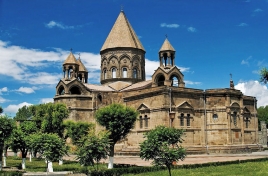Vagharshapat
Wednesday, June 8, 2022
Vagharshapat is the 4th-largest city in Armenia. The city is best known as the location of Etchmiadzin Cathedral and Mother See of Holy Etchmiadzin, the center of the Armenian Apostolic Church. It is thus unofficially known in Western sources as a "holy city" and in Armenia as the country's "spiritual capital" (հոգևոր մայրաքաղաք). It was one of the major cities and a capital of ancient Greater Armenia. Reduced to a small town by the early 20th century, it experienced large expansion during the Soviet period becoming, effectively, a suburb of Yerevan. Its population stands just over 37,000 based on 2016 estimates.
According to Movses Khorenatsi, the area of Vagharshapat was known as Artimed, derived from the ancient Greek deity Artemis. Later, it was renamed Avan Vardgesi or Vardgesavan by Prince Vardges Manouk who rebuilt the settlement near the shores of Kasagh River, during the reign of King Orontes I Sakavakyats of Armenia (570–560 BC). However, in his first book, Wars of Justinian, the Byzantine historian Procopius refers to the city as Valashabad, named after king Vologases I of Armenia. The name evolved into its later form by the shift of the medial l into a gh, which is common in the Armenian language. Movses Khorenatsi mentioned that the town of Vardges was entirely rebuilt and fenced by King Vagharsh I to become known as Norakaghak and later Vagharshapat.
The territory of ancient Vagharshapat was inhabited since the 3rd millennium BC. Many sites, such as Metsamor Castle, Shresh hill and Mokhrablur hill date back to the neolithic period. The first written records about Vagharshapat were found in the inscriptions left by the Urartian king Rusa II (685–645 BC), where it was mentioned as Kuarlini. The inscription found in the archaeological site of ancient Vagharshapat cites to a water canal opened by king Rusa II, between Ildaruni river (Hrazdan River) and the valley of Kuarlini.
According to 5th-century writer Movses Khorenatsi, the oldest name of Vagharshapat was Artimed, derived from the ancient Greek deity Artemis. Later, it was renamed Avan Vardgesi or Vardgesavan after being rebuilt by prince Vardges Manouk near the shores of Kasagh River, during the reign of king Orontes I Sakavakyats of Armenia (570–560 BC).
Under the reign of king Tigranes the Great (95–55 BC), the town was partly inhabited by Jewish captives.
In the first half of the 1st century AD, under the reign of the Armenian Arsacid king Vagharsh I of Armenia (117–144), the old town of Vardgesavan was renovated and renamed Vagharshapat. In his first book Wars of Justinian, the Byzantine historian Procopius has cited to the city as Valashabad (Balashabad), named after king Valash (Balash) of Armenia. The name evolved into its later form by the shift in the medial L into a Gh, which is common in the Armenian language. Movses Khorenatsi mentioned that the Town of Vardges was entirely rebuilt and fenced by king Vagharsh I to become known as Noarakaghak and later Vagharshapat.
Vagharshapat has served as the capital of the Arsacid Kingdom of Armenia between 120 AD and 330 AD. After embracing Christianity as a state religion in Armenia in 301, Vagharshapat was gradually called Ejmiatsin, after the name of the Mother Cathedral; the seat of the Armenian Catholicosate, which is considered one of the oldest religious organizations in the world. As a spiritual center of the entire Armenian nation, Vagharshapat has grown up rapidly and developed as an important center of education and culture. The city was home to one of the oldest educational institutions in Armenia founded by Mesrop Mashtots.
The political capital of the Armenian kingdom was transferred to the city of Dvin in 336.





